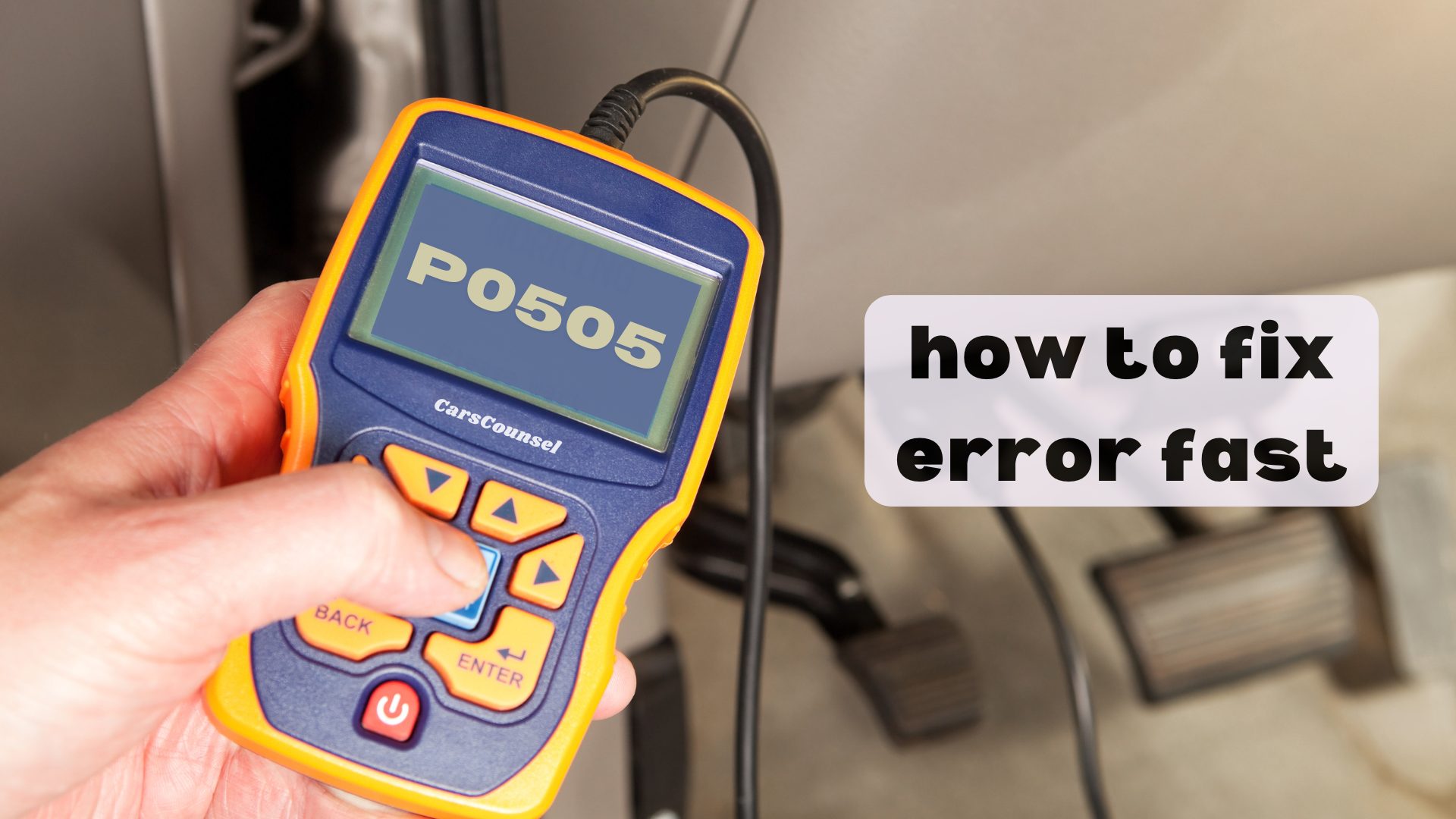You’ve got an annoying P0505 code flashing on your dashboard, and you’re wondering what to do next.
This code points to a problem with your Idle Air Control (IAC) system, which can cause rough idling or even stalling.
Before you get too worried, there are some easy steps you can take to fix this OBD2 Codes issue quickly.
From using an OBD II scanner to check the error to looking for vacuum leaks, each step is important.
But how can you make sure you’re not missing anything crucial?

Quick Navigation
Key Takeaways
- Check and clean the Idle Air Control Valve (IACV) to make sure it works right.
- Use a smoke test to find and fix any vacuum leaks in the system.
- Look at the throttle body for carbon buildup and clean it well.
- Use a multimeter to test the IAC valve’s electrical resistance and replace it if it’s not within the normal range.
What Is the P0505 Code?
The P0505 code means there’s a problem with the Idle Air Control (IAC) system, which helps manage your car’s idle speed.
The IAC system adjusts the air that goes around the throttle plate to keep the engine idling smoothly. If the IAC system isn’t working right, your engine mightn’t idle as it should, usually staying between 800 and 1000 RPM.
This issue can lead to rough idling or even stalling. Knowing how the IAC system works is key to fixing the P0505 code.
When your IAC system is in good shape, your engine runs better and uses fuel more efficiently.
Symptoms of P0505 Code
When your car shows a P0505 code, you might notice problems like rough idling, stalling, and the Check Engine Light turning on. These issues suggest there’s something wrong with your vehicle’s idle speed control, which affects how well the engine runs.
Here are the symptoms you might see:
- Rough Idling: The engine’s idle speed is inconsistent, causing it to vibrate or shake.
- Stalling: The engine may unexpectedly shut off, especially when you stop.
- Check Engine Light: The Check Engine Light will come on, signaling an issue.
Noticing these signs early can prevent more serious problems. Fixing the P0505 code quickly ensures your engine runs well and helps save fuel.
Common Causes
If your engine’s idle speed isn’t being regulated properly and you see a P0505 code, it might be because of a few common issues.
These include a malfunctioning idle air control valve (IACV), a dirty throttle body, or vacuum leaks. It’s important to keep the IAC valve in good shape to avoid these problems.
Over time, carbon can build up in the IACV or throttle body, blocking airflow and messing with idle speed.
Also, worn-out or damaged vacuum hoses can cause leaks that make idle control even harder.
A bad throttle position sensor (TPS) can also send wrong signals, making the issue worse.
Regularly checking and cleaning these parts can help prevent these problems.
Keeping an eye on these things will help your engine run smoothly and avoid the P0505 code.
Diagnostic Tools
To fix the common causes of the P0505 code, you’ll need reliable tools to find the exact problem.
Accurate diagnostics are key for keeping your engine running smoothly. Here’s a quick list of tools you’ll need:
- OBD II Scanners: These devices read and clear trouble codes. They give you real-time data on how the engine is performing and help you confirm the P0505 code.
- Multimeter: Use this to test the electrical resistance of the Idle Air Control (IAC) valve and make sure it’s within the manufacturer’s specs.
- Smoke Machine: This tool helps you find any vacuum leaks, which are often the cause of the P0505 code.
With these tools, diagnosing and fixing the P0505 code becomes simple and efficient.
Identifying Vacuum Leaks
Finding vacuum leaks involves a step-by-step method to locate the exact spot where the leak is happening in the engine’s vacuum system.
Start by looking closely at all the hoses to see if any are cracked or have come loose.
For a more accurate check, do a smoke test. Push smoke into the vacuum system and watch to see where it comes out, showing you where the leak is.
This method is great because it can find even tiny leaks that are hard to see.
Make sure the engine is off during the test to get accurate results.
Testing the IAC Valve
After finding any vacuum leaks, you should test the Idle Air Control (IAC) valve to make sure it’s working right. Here’s how to do it:
- Unplug the IAC Valve: Disconnect the electrical connector from the IAC valve. This will isolate the valve so you can test it accurately.
- Check the Resistance: Use a multimeter to check the resistance between the terminals of the IAC valve. Look at your vehicle’s service manual to find the correct resistance range.
- Look and Clean: Check the valve for any carbon buildup or debris. Clean the IAC valve with a suitable cleaner to ensure it’s free from dirt and contaminants.
Repairing the IAC Valve
Fixing the Idle Air Control (IAC) valve often means giving it a good cleaning or swapping it out for a new one to get your engine’s idle speed back to normal.
First, disconnect the battery for safety.
To clean the IAC valve, take it off and use throttle body cleaner to remove any carbon buildup. Make sure all the passages are clear before you put it back.
If cleaning doesn’t help, you’ll need to replace the valve. Take off the old valve, put in the new one, and reconnect the electrical connectors.
Double-check that everything is installed correctly and use an OBD-II scanner to clear any error codes.
Following these steps will help your engine idle smoothly and stop the P0505 code from coming back.
Fixing Vacuum Leaks
How to Fix Vacuum Leaks
To fix vacuum leaks, start by doing a smoke test to find any leaks in the engine’s vacuum system. This will help you spot problem areas around the vacuum hose and air intake.
Once you’ve found the leaks, follow these steps:
- Look and Replace: Check all vacuum hoses for cracks or disconnections. Replace any damaged hoses right away.
- Tighten Connections: Make sure all connections are tight and secure around the air intake and other parts.
- Check Gaskets: Look at the gaskets connected to the air intake for any signs of wear or damage and replace them if needed.
Resetting the ECM
Resetting the ECM can clear stored trouble codes and bring your engine back to its best performance after repairs.
To reset your ECM, disconnect the negative battery terminal for 15 minutes. This will erase the memory, allowing the ECM to relearn its settings.
After reconnecting the battery, start your engine and let it idle for a few minutes to finish the ECM reprogramming. This helps recalibrate the idle control, ensuring your engine runs smoothly.
Make sure to drive normally for about 20 minutes afterward, so the ECM can adjust to different driving conditions.
Resetting the ECM is a simple but important step to make sure the P0505 code issue is fixed and that your engine runs efficiently.
Preventative Maintenance Tips
Regularly check and clean the Idle Air Control (IAC) valve to make sure it’s not dirty and works well. Keeping the IAC valve in good shape is key to avoiding engine problems and ensuring your engine runs smoothly.
Also, make sure your air intake system is clean to prevent blockages that can mess with your engine’s idle speed and cause issues.
Follow these steps to take care of your vehicle:
- Clean the IAC Valve: Use the right cleaning products to get rid of dirt and buildup.
- Check Vacuum Hoses: Regularly look for cracks or wear and replace any damaged hoses right away.
- Watch Engine Performance: Pay attention to any unusual idling or stalling, as these could be early signs of IAC or air intake problems.
More OBD-II Codes
Frequently Asked Questions
Can Extreme Weather Conditions Trigger the P0505 Code?
Yes, extreme weather can cause the P0505 code to appear. High humidity or very cold temperatures can mess with sensor performance, which might lead to faulty sensors or vacuum leaks, causing problems with idle air control.
How Long Does It Typically Take to Fix the P0505 Code?
Did you know that 75% of P0505 repairs take less than 2 hours? Diagnostic tools help identify the problem, and the repair time depends on the issue. Replacing an IAC valve usually takes less than an hour, but fixing vacuum leaks might take longer.
Are Aftermarket IAC Valves Reliable for Fixing the P0505 Code?
Aftermarket IAC valves can work well if you pick good brands. Make sure the part matches OEM specs for best results. Always test the IAC valve after putting it in to make sure it fixes the problem.
Can Driving Habits Influence the Occurrence of the P0505 Code?
Imagine your engine having trouble staying steady when idling. Your driving habits can affect whether the P0505 code pops up. Often stopping and starting while driving puts stress on the Idle Air Control (IAC) valve, which can mess with engine performance and cause this error code.
Is It Expensive to Fix the P0505 Code in Older Car Models?
Yes, fixing the P0505 code in older cars can be reasonably priced. Parts like Idle Air Control (IAC) valves and vacuum hoses don’t cost much, but labor costs can add up. Regular maintenance can help keep unexpected repair costs down and make them easier to handle.
Conclusion
In short, fixing the P0505 code doesn’t have to be super hard. Use an OBD II scanner, clean the IAC valve and throttle body, and check for any vacuum leaks to solve the problem.
After that, reset the ECM by disconnecting the battery for 15 minutes. This will help keep your engine running smoothly.
Remember, it’s better to prevent problems than to fix them later.

